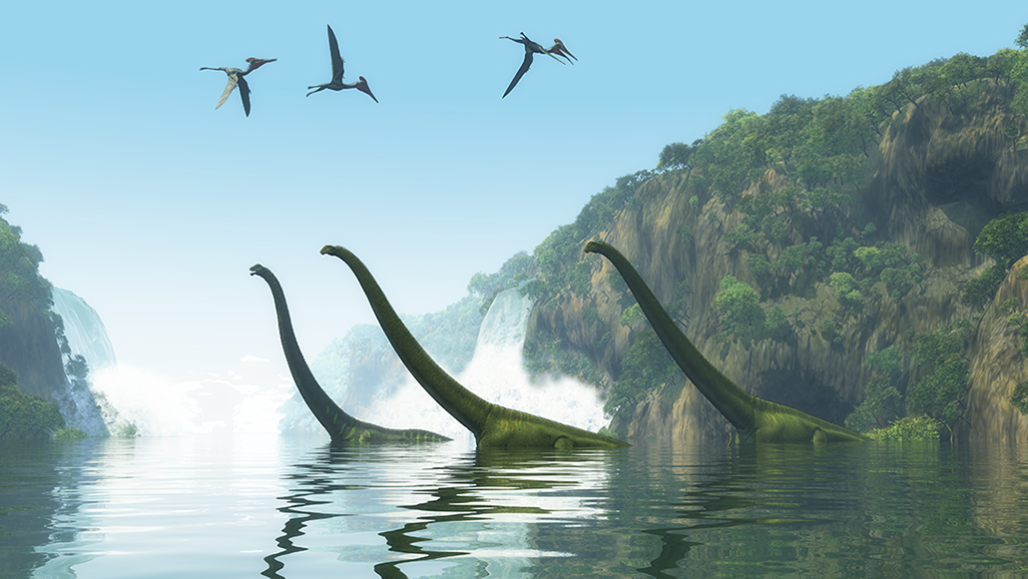birds: Warm-blooded animals with wings that first showed up during the time of the dinosaurs. Birds are jacketed in feathers and produce young from the eggs they deposit in some sort of nest. Most birds fly, but throughout history there have been the occasional species that don’t.
conifer: Cone-bearing trees or shrubs such as the pine, fir, spruce or yew. Conifers are usually evergreen and have either needle-shaped or scale-like leaves.
continent: (in geology) The huge land masses that sit upon tectonic plates. In modern times, there are six established geologic continents: North America, South America, Eurasia, Africa, Australia and Antarctica. In 2017, scientists also made the case for yet another: Zealandia.
dinosaur: A term that means terrible lizard. These ancient reptiles lived from about 250 million years ago to roughly 65 million years ago. All descended from egg-laying reptiles known as archosaurs. Their descendants eventually split into two lines. For many decades, they have been distinguished by their hips. The lizard-hipped line are believed to have led to the saurichians, such as two-footed theropods like T. rex and the lumbering four-footed Apatosaurus (once known as brontosaurus). A second line of so-called bird-hipped, or ornithischian dinosaurs, appears to have led to a widely differing group of animals that included the stegosaurs and duckbilled dinosaurs. But a new 2017 analysis now calls into question that characterization of relatedness based on hip shape.
evolve: (adj. evolving) To change gradually over generations, or a long period of time. In living organisms, such an evolution usually involves random changes to genes that will then be passed along to an individual’s offspring. These can lead to new traits, such as altered coloration, new susceptibility to disease or protection from it, or different shaped features (such as legs, antennae, toes or internal organs). Nonliving things may also be described as evolving if they change over time. For instance, the miniaturization of computers is sometimes described as these devices evolving to smaller, more complex devices.
extinction: The permanent loss of a species, family or larger group of organisms.
forest: An area of land covered mostly with trees and other woody plants.
fossil: Any preserved remains or traces of ancient life. There are many different types of fossils: The bones and other body parts of dinosaurs are called “body fossils.” Things like footprints are called “trace fossils.” Even specimens of dinosaur poop are fossils. The process of forming fossils is called fossilization.
Jurassic: Lasting from about 200 million to 145.5 million years ago, it’s the middle period of the Mesozoic Era. This was a time when dinosaurs were the dominant form of life on land.
mammal: A warm-blooded animal distinguished by the possession of hair or fur, the secretion of milk by females for feeding their young, and (typically) the bearing of live young.
marine: Having to do with the ocean world or environment.
microscopic: An adjective for things too small to be seen by the unaided eye. It takes a microscope to view objects this small, such as bacteria or other one-celled organisms.
plankton: A small organism that drifts or floats in the sea. Depending on the species, plankton range from microscopic sizes to organisms about the size of a flea. Some are tiny animals. Others are plantlike organisms. Although individual plankton are very small, they form massive colonies, numbering in the billions. The largest animal in the world, the blue whale, lives on plankton.
pterosaur: Any of various extinct flying reptiles of the order Pterosauria. These animals lived 245 million years ago to 65 million years ago. Although not true dinosaurs, they lived during the reign of dinosaurs. Among members of this order were the pterodactyls of the Jurassic and Cretaceous periods, which were characterized by wings consisting of a flap of skin supported by the very long fourth digit on each forelimb.
reptile: Cold-blooded vertebrate animals, whose skin is covered with scales or horny plates. Snakes, turtles, lizards and alligators are all reptiles.
species: A group of similar organisms capable of producing offspring that can survive and reproduce.
tyrannosaur: A line of meat-eating dinosaurs that began during the late Jurassic Period, about 150 million years ago. These species persisted into the late Cretaceous Period, about 65 million years ago. The best known member of these species: the late Cretaceous’ Tyrannosaurus rex, a 12-meter (40 foot) long top predator of its time.








